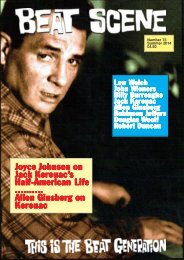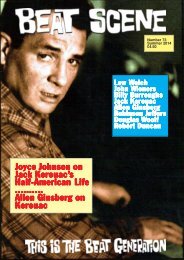You also want an ePaper? Increase the reach of your titles
YUMPU automatically turns print PDFs into web optimized ePapers that Google loves.
The Haunted Life<br />
re-introduces and it made me smile, make that beam,<br />
is Albert Halper. Now Halper possibly does need a<br />
little introduction here. It’s as though he never<br />
existed. Beat Scene, mostly through the efforts of Jim<br />
Burns, has attempted to bring him back from the<br />
dead – though it appears his works remain resolutely<br />
out of print. He was a socialist writer, mentioned in<br />
the same breath as Dos Passos. He wrote of the<br />
workplace, the workers, the downtrodden, he wrote<br />
of trade unions when America really had those<br />
organisations on a par with Communism.<br />
McCarthyism saw to that. He<br />
was out on a limb. And Kerouac<br />
loved his work, he and Sebastian<br />
Sampas, his young Greek friend<br />
in Lowell who was killed in the<br />
Second World War, almost before<br />
he needed to shave. They read<br />
and digested his work as eagerly<br />
as they did Saroyan and Wolfe<br />
and others. Kerouac includes<br />
some initial thoughts on Halper<br />
in his book, “Peter read slowly,<br />
admiring the young Halper’s tragic<br />
sense of youth and lonesomeness.”<br />
Kerouac, through Peter Martin,<br />
imagines Albert Halper in<br />
Manhattan, daydreams of one<br />
day being like him. Discussing<br />
Peter’s room and listing Halper<br />
amongst the Russian novelists<br />
and Sherwood Anderson’s and the<br />
like, his favourite books. So it is gratifying that the<br />
forgotten Halper is remembered and maybe, just<br />
maybe, some enterprising publisher will resurrect him<br />
and bring him to new readers.<br />
The Haunted Life is very much a forerunner to<br />
The Town and the City. Peter Martin is here in<br />
embryonic shape alongside Garabed Tourian and<br />
Dick Sheffield – characters based on Sebastian and<br />
on another Lowell friend Billy Chandler. Sadly<br />
Chandler was another World War Two casualty.<br />
Imagine losing two of your best friends aged twenty<br />
something? And Joe Martin is heavily based on<br />
Kerouac’s father Leo, about whom Jack had mixed<br />
feelings. They clashed, let’s put it like that. Like<br />
Kerouac’s mother, his dad had some questionable<br />
beliefs. In fact the book commences with Joe Martin<br />
bemoaning the state of his America, it is a vicious<br />
Archie Bunker or Alf Garnett tirade that is evidently a<br />
regular feature in the Kerouac household – a what is<br />
the country coming to soliloquy.<br />
Handling his loss of Sebastian and Billy – they<br />
are both dead as Kerouac begins to memorialise them<br />
both - and faced with his father’s racist tirades<br />
Kerouac captures the changing times, Benny<br />
Goodman records over the radio heralding a new<br />
mood, a new deal in Roosevelt’s USA. That sense of a<br />
change is gonna come that Kerouac was so desperate<br />
to capture in his work. The idea that the awesome<br />
swathes of rural America were not immune to the<br />
coming of the new highways, the radio, with<br />
television just around the corner. Nowhere would<br />
remain untouched and<br />
this kid Kerouac is so<br />
aware for his tender<br />
years, in tune, listening<br />
to the pounding drums,<br />
the dustcloud in the<br />
distance as modernity<br />
approaches, he sees it all.<br />
And he’s just this kid.<br />
Can you believe it? And<br />
there’s shades of his<br />
beloved Dostoevsky and<br />
of Proust. It is one of the<br />
more successful early<br />
Kerouac works. Present<br />
are the vital excesses of<br />
his prose, Peter Martin<br />
listening to the sounds of<br />
Galloway through his<br />
open window in the cool<br />
of the evening, “Again<br />
the train…moving north to Montreal…howling long<br />
and hoarse, a mournful night sound…<br />
Silence now for a moment…and the river hush, and the<br />
trembling of tree leaves. Far across the field, over the<br />
tracks and over to the boulevard across the river, where<br />
the cars move endlessly back and forth from the city to<br />
the ice cream road stands, the fried clam restaurants, the<br />
pink-lit roadhouses all crowded with shuffling dancers,<br />
the faint beep of klaxons returns.” (page 42)<br />
He’s already an incurable romantic about the<br />
endless possibilities of America. Even at this tender<br />
age. He can’t possibly see and hear all these things<br />
lying on his bed in his room, can he, but he does. All<br />
the portents are there. The signals that – okay he’s in<br />
the full glare of Thomas Wolfe and overblown,<br />
sometimes like a dazzled rabbit in the headlights, but<br />
he’s on the verge of finding his voice. And you know<br />
the story is a remembrance and tribute to his lost<br />
friends Sebastian and Billy. Kerouac has an almost<br />
camera like movement between Lowell houses as they<br />
Jack Kerouac aged 20<br />
56





